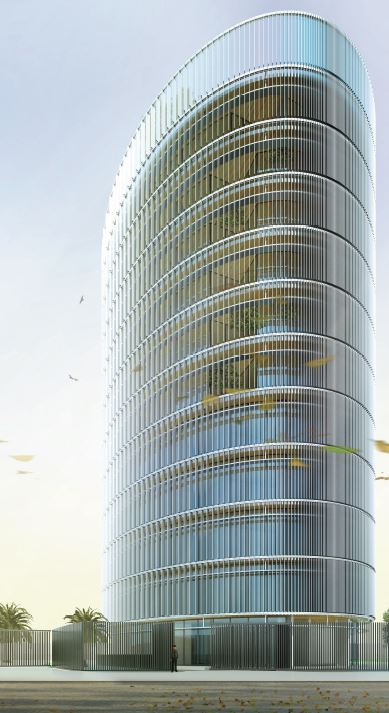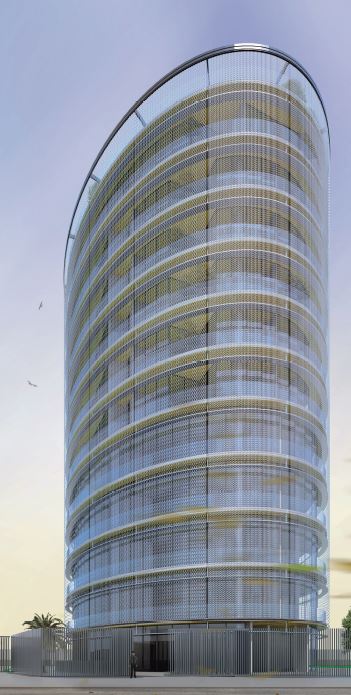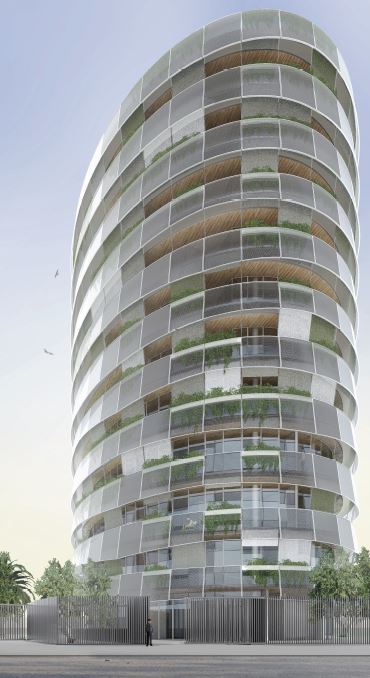Ecobuilding with shutters in Africa
Green buildings are emerging all over the world and all have a priority objective: to minimizing, and if possible reducing to zero the amount of consumed energy… most of the time by heating buildings in winter. The big challenge is therefore insulation to minimize heat loss during the cold season. Designers then hunt for air holes, try to incorporate heat-insensitive materials, optimize room lighting during the cold season, etc.
But what about green buildings in Africa, which consume less energy for heating than European buildings. Would not there be ecological issues in Africa? Que nenni! But the stakes are different: for most African countries, the energy spent on heat must be saved. Air conditioning is the energy abyss of many African, Asian and American buildings.
Paradoxically, there are few examples of buildings with true ecological characteristics. We must look for them, find them, we will say it ourselves. And yet, when we find them, we find real nuggets.
Among these nuggets, here is the project "9 degrees" Hassan Hachem designed the BAD architectural firm.
This is a tower project for Equatorial Guinea.
The project initially set strong constraints and
objectives.
1. Minimizing the absorption of solar heat from outside
2. Reducing
the demand for primary energy for cooling and ventilation by means of
passive systems
3. Optimally using sunlight during the day
4. Saving
water
5. Improving landscape and biodiversity
6. Closing the life
cycle and future adaptability
7. Reducing / Reuse / Recycle
8. LEED
and environmental management
The result is surprisingly elegant and
advanced from a technical point of view. Currently, the project is being
finalized and three options have been explored.
1. Minimizing vertical solar heat absorption through fixed blades.

In warm climates such as Equatorial Guinea, to minimize the absorption of
solar heat through the outer skin, avoid direct sunlight on the exterior
facade. While the shadow of the outer walls is paramount, it can have a
negative impact on natural lighting levels indoors especially in offices.
Option A uses vertical blades of the same type at different distances to
filter the direct sunlight before it crossed windows and walls, in all solar
directions. Whereas deep blades are a traditional African solution
(protecting during the dry season, but allowing the sun, in the rainy
season, to heat the building in the mornings), sunscreens covering the
entire facade allow a more uniform intensity and a more compact built
volume.
2. Minimizing vertical solar heat absorption through fixed blades.

In warm climates such as Equatorial Guinea, to minimizing the absorption
of solar heat through the outer skin, direct sunlight should be avoided the
outer walls. While the shadow of the outer walls is paramount, it can have a
negative impact on natural lighting levels indoors especially in offices.
Option A uses vertical blades of the same type at different distances to
filter the direct sunlight before it crosses windows and walls in all solar
directions. Whereas deep blades are a traditional African solution
(protecting in the summer, but allowing the winter sun to warm up the
building in the mornings), sunscreens covering the entire facade allow a
more uniform intensity and a mor compact built volume.
3. Minimize solar heat absorption through a cantilever slab.

Again, in warm climates like Equatorial Guinea, to minimize absorption of
solar heat through the outer skin, it is necessary to prevent the light from
sun falls directly on the outer walls. While the shadow of the outer walls
is essential, it may have a negative impact on the indoor levels of natural
lighting, especially in offices.
According to Hassan Hachem, the
project's promoter, the three design options aim to set a new benchmark for
sustainable design in the Central African region. It's also about getting a
high LEED level or some other instrument of sustainable design.
The future will tell if this project is keeping its promises, but
in any case, the initiative deserves to be welcomed.
Equatorial Guinea's equatorial climate poses unique challenges and opportunities for green building design. One significant challenge is the high humidity and consistent heat, which demand innovative cooling solutions to reduce reliance on energy-intensive air conditioning systems. Hassan Hachem's "9 degrees" project is a prime example of how these challenges can be addressed with creativity and sustainability at the forefront.
A critical element of the "9 degrees" project is its emphasis on passive cooling techniques. These methods reduce the dependency on mechanical cooling, thereby conserving energy. The use of vertical blades to filter direct sunlight is particularly effective in Equatorial Guinea's climate. These blades not only provide shade but also ensure that the building remains cool without compromising on natural light. This is crucial in office settings where adequate daylight is essential for productivity and well-being.
Moreover, the project includes advanced water-saving mechanisms, which are vital in a region where water scarcity can be an issue. Implementing greywater recycling systems and efficient plumbing fixtures helps conserve this precious resource. By focusing on water conservation, the "9 degrees" project sets a precedent for future developments in Equatorial Guinea and other similar climates.
The project also prioritizes biodiversity and landscape enhancement, which are often overlooked in urban developments. By incorporating green roofs and native plant species, the building not only improves the local ecosystem but also provides natural insulation, further reducing the need for artificial cooling. This holistic approach to sustainability is what sets the "9 degrees" project apart from other developments in the region.
Hassan Hachem's vision extends beyond just creating an energy-efficient building. He aims to establish a new standard for sustainable architecture in Central Africa. "In Equatorial Guinea, we have the opportunity to redefine what it means to build sustainably in tropical climates," Hachem explains. "Our approach must be comprehensive, integrating energy, water, and biodiversity solutions to create truly resilient structures."
The commitment to achieving high LEED certification underscores the project's dedication to environmental stewardship. By adhering to rigorous sustainability standards, the "9 degrees" project not only benefits its immediate environment but also serves as a model for other countries with similar climatic challenges. This is particularly important as the effects of climate change become more pronounced, necessitating more resilient and sustainable building practices globally.
The "9 degrees" project in Equatorial Guinea is a testament to the potential of green building practices in tropical climates. By focusing on passive cooling, water conservation, and biodiversity, the project addresses the unique challenges of its environment while setting a high standard for sustainability. As Hassan Hachem aptly puts it, "Sustainable development in Equatorial Guinea is not just a necessity; it is an opportunity to innovate and lead by example."